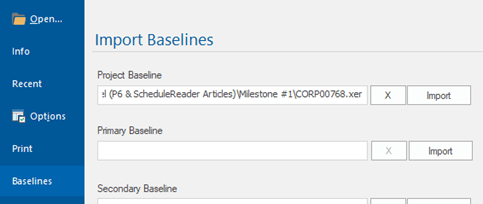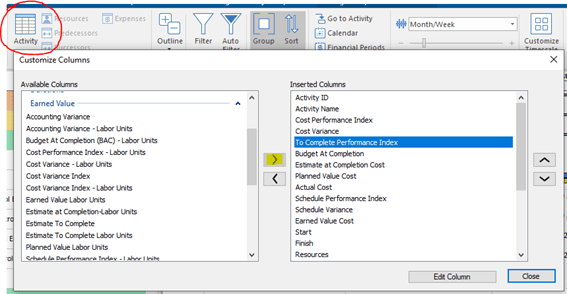There is More Than One To Complete Performance Index (TCPI)
The Earned Value Management (EVM) index of the To Complete Performance Index (TCPI) is a mathematical projection of the cost performance in a project that must be achieved on the remaining project work to meet the agreed-to business goals of the establishment. These agreed-to business goals include the Estimate at Completion (EAC) or the Budget at Completion (BAC). Both of these earned value indices must be understood first to better grasp the concept of the TCPI, as well as a few others that will be briefly covered in this article.
BAC to start is the original total budget estimate that was established before the start of a project. The EAC is established when there is an expected change from the original BAC in the future. The EAC formula is comprised of the current Actual Cost (AC) that is added to the remaining value (Earned Value, or EV) of the work expected to be performed on the project. The formula translates to EAC = AC + (BAC – EV). EAC, which is the total dollar value of the project, should not be confused with the Estimate to Complete (ETC), which is the amount of funding required to complete the remainder of the project’s work. Think of the ETC as strictly the forecast of the project.
Before evaluating the TCPI formula, it is also a good idea to understand the earned value indices for both the Budgeted Cost of Work Performed (BCWP), the Actual Cost of Work Performed (ACWP), and the Planned Value (PV). The BCWP signifies the budgeted cost of the value of the work that has been achieved, or the earned value (EV). The ACWP signifies the actual cost incurred for the work that was completed. The ACWP is known as a project’s actuals, and these actuals are often recorded, stored, and monitored in an organization’s accounting system. In opposition to the ACWP, the PV represents the value (the earned) that should have been realized, per the project schedule.
Understanding the Cost Performance Index (CPI) helps differentiate between it and the TCPI cost indices. The CPI is a calculation of the BCWP (actual cost/earned performed) to the ACWP (actual cost incurred and documented), making the formula the calculation of CPI = Earned Value / Actual Cost. The CPI is the metric revealing the current health of the project from a cost perspective. For a detailed explanation of the CPI and its function, please refer to the following link here.
Basing the “To Complete Performance Index” TCPI on EAC – TCPIEAC and TCPIe
TCPI is the ratio between the remaining work to the project’s remaining funds. The “To Complete Performance Index” or TCPI is the efficiency level that must be achieved to complete the project work at the EAC value, which was constructed earlier in the project when the costs first strayed from the original plan (the BAC). A project manager can determine the level of performance (earned value) that will be required to achieve the project’s goals by using the TCPI formula, which can determine the action required for the future cost health of the project.
There are two formulas for calculating the TCPI of a project, which makes this cost-efficiency indicator unique from the other earned value indices that we commonly utilize. The first TCPI formula that we will discuss is the most commonly utilized TCPIEAC indicator, which is the future cost-efficiency factor implemented to reach a specific EAC. Be aware that Primavera P6 sets the BAC equal to the EAC so that it only uses the EAC in its TCPI calculations. This calculation in Primavera P6 assumes that the original BAC is no longer realistic or attainable.
The formula is calculated in the following manner:
TCPIEAC = Work Remaining / Cost Remaining (ETC)
Or
TCPIEAC = (BAC-BCWPCUM) / (EAC-ACWPCUM)
In the following EVM examples to demonstrate the two different formulas for TCPI, we will use financial data from the top level of the project schedule. The current and main project view shows specific columns that we selected that are beneficial to our calculations:

The Primavera P6 schedule contains the following dollar values:
- BAC = $1,261,288.47
- EAC = $1,258,003.93
- PV = $441,519.62
- BCWP = $403,673.55
- ACWP (ACWPCUM, or Actual Total Cost) = $436,490.62
- CPI = 0.92
- TCPI = 1.04

You must use the actual total cost in Primavera P6 when you measure TCPIEAC. Using our TCPIEAC formula listed above, we subtract the BCWP (cum) from the BAC, or $1,261,288.47 minus $403,673.55. We then subtract the ACWP (remember to use the cum, or actual total cost in Primavera P6) from the EAC or $1,258,003.93 minus $436,490.62. Next, divide the resulting $857,614.92 by $821,513.31, and we get 1.043945252694689. Finally, round the figure to 1.04, and that is our TCPIEAC.
The CPI of 0.92 indicates that for every $1.00 that we have spent so far on the project, we have earned $0.92 of earned value. Therefore, the TCPIEAC indicates that for every future $1.00 that we spend on this project, that we need to earn $1.04 to reach our target EAC. This is a slightly aggressive but realistic indicator of the measurement required to catch up to since the differential between the CPI and the TCPI is less than 0.10. If the differential was greater than 0.10, the variance would indicate that the EAC requires possible re-evaluation since a variance greater than 0.10 is often not attainable for project recovery. The project team must ensure that project health measurements such as the TCPI, are analyzed regularly to avoid large variances and surprises well into the project.
Basing the TCPI on BAC – TCPIBAC or TCPIB
The second and less common TCPI formula is the TCPIBAC, which represents the future cost efficiency and performance that is required to meet the original budget, or BAC, for the project. The EAC indicator is replaced with the BAC indicator to obtain the result, and Primavera P6 does not use this calculation to determine TCPI. Both TCPIBAC and TCPIBAC are effective to use; however, you will want to ask yourself which outcome you are trying to accomplish so that you can use the correct TCPI formula for your project condition. Project managers who are trying to remain within the original budget parameters will typically use the TCPIBAC. However, many project managers are basing their evaluations on a revised estimate or they are simply using the Primavera P6 default configuration, which is the TCPIEAC, not the TCPIBAC.
The formula is calculated in the following manner:
TCPIBAC = Work Remaining / Cost Remaining (ETC)
Or
TCPIBAC = (BAC-BCWPCUM) / (BAC-ACWPCUM)

Using our TCPIBAC formula listed above, we subtract the BCWP (cum) from the BAC or $1,261,288.47 minus $403,673.55. We then subtract the ACWP (remember to use the cum, or actual total cost in Primavera P6) from the BAC or $1,261,288.47 minus $436,490.62. Next, divide the resulting $857,614.92 by $824,797.85, and we get 1.039788015936269. Finally, round the figure up to 1.04, and that is our current TCPIBAC. In this example, the TCPIBAC is almost identical to the TCPIEAC; it is different only by a fraction. In some situations; however, the two figures can be significantly different. Keep in mind that the TCPI result in this project indicates that the recovery required to reach the BAC is realistic and attainable and that the EAC has not strayed too far from the original budget.
Conclusion
The TCPI is a unique Earned Value Management metric in that it provides the project team with an efficiency factor that realistically determines the amount of effort that it will take to catch up on a project once it has deviated from the budget baseline. If utilized early in the project, TCPI can help the project team avoid cost overruns.
Utilizing ScheduleReader and the To Complete Performance Index
ScheduleReader is Windows-friendly and supports Excel and XML file types, and it serves as an interface to view activities and generate progress from tools such as Primavera P6. Besides, ScheduleReader offers an inexpensive licensing alternative to Primavera P6 for large teams that do not have full access to Primavera P6 to be able to view schedule progress and stay current with the project team’s progress.
Team members without a Primavera P6 license can easily open and view schedules in the Primavera P6 XER format, thus allowing those lacking Primavera P6 access the ability to utilize similar views for EVM metrics as those in Primavera P6. This section of the article documents how a ScheduleReader user can import and view a Primavera P6 XER schedule in the ScheduleReader software to use the TCPI formula.
Importing the Primavera P6 XER Schedule and Baseline into ScheduleReader
Launch ScheduleReader and select the File tab to open the location to retrieve the XER file that has been exported from Primavera P6. The initial view in the Activities tab offers several possibilities to view the schedule data (more on this shortly):

Ensure that you select the File tab again to import the Primavera P6 baseline associated with the XER. After selecting the File tab, select “Baselines” and designate the appropriate Primavera P6 XER file associated with the project’s baseline under the “Project Baseline” section:

If the Primavera P6 schedule also contains a secondary or tertiary baseline, you can also assign these in the “Import Baselines” section by selecting and importing the same Primavera P6 XER file.
Customizing Columns in ScheduleReader to Show the “The To Complete Performance Index (TCPI)”
ScheduleReader’s “Activity” feature closely resembles Primavera P6’s customizable columns setup. Select the “Activity” icon and use the “Available Columns” on the left side to choose your column selections. The arrows can be used to move the editable columns in the “Inserted Columns” box on the right side.
In this example and for this exercise, we will use selections under “Earned Value” to select the CPI, CV, TCPI, BAC, EAC, PV cost, AC, SPI, SV, and EV cost. We used the top arrow in the center to move the contents from the Available Columns to the Inserted Columns. Use the arrows on the right side to move the contents of the Inserted Columns box in preferred order:

Efficiencies for Team Collaboration Using ScheduleReader and the TCPI
TCPI can help the project manager and the project team stay on top of their projects and monitor their costs. Utilizing ScheduleReader offers the project team additional convenient features for team collaboration, such as its customizable layouts that can be viewed easily from an imported Primavera P6 XER file, whether the user has access to Primavera P6 or not. This function allows cross-team collaboration while keeping all members of the project team up to date on the most current project schedules, and the TCPI can be a powerful indicator and measuring stick to understand the effort required to recover the project costs if used regularly.
About the Author
Melanie Calverley is an experienced professional with several years of knowledge and practice in Project Management as a Program Cost and Schedule Control Analyst on multi-million/multi-billion-dollar projects, Project Controls, Strategic Planning, Engineering Planning, Earned Value Management (EVM), and Earned Value Management System (EVMS) implementation, Configuration Management, and writing/editing. She commands full utilization of Primavera P6 software, MS Project, and MS Project Server. Her career background includes industry experience in oil and gas, energy, aerospace/defense, IT, litigation, and media.
Calverley has extensive experience in the planning and scheduling arena since 1999, as well as extensive experience in the aerospace and oil and gas industries combined. Calverley has worked for the large and high-visibility players in the aerospace industry – Boeing and Lockheed Martin, as well as the large companies in the O&G industry, such as Schlumberger, GE Energy, and Chevron. She supported NASA directly and a host of smaller sub-contractors over the years before exploring the O&G and IT industries. Calverley understands the strict, organized flow of the aerospace industry’s horizontal and vertical logic integration, the criticality of resource loading, and the reporting functions that support Earned Value Management (EVM). She has also participated in various audits such as DCMA audits, JSRs, ISRs, and CAM reviews. In 2013, Calverley was responsible for implementing a full EVMS in Primavera for Cameron International’s (now Schlumberger) Process Systems Division across the globe. The system was fully tested and successfully implemented and run in the United States, Brazil, the UK, Malaysia, Singapore, and the Middle East.
Calverley owns her own business, Calverley Consulting, LLC, which has been operational since 2017. Calverley is also a solid writer, editor, and process flow documentation expert. She possesses a full command of the proper English language, and she is also a published book author. Calverley developed and championed multiple process flows and written documentation via policies and procedures for various well-known companies.

